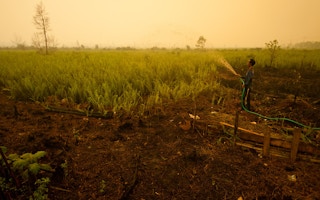Climate change is leaving crops at risk. Driven by global warming – and with it ever greater extremes of heat, drought and rainfall – the rising mercury can explain up to half of all variations in harvest yields worldwide.
Unusually cold nights, ever greater numbers of extremely hot summer days, weeks with no rainfall, or torrents of storm-driven precipitation, account for somewhere between a fifth to 49 per cent of yield losses for maize, rice, spring wheat and soy beans.
And once international scientists had eliminated the effect of temperature averages across the whole growing season, they still found that heatwaves, drought and torrential downfall accounted for 18 per cent to 43 per cent of losses.
In a second study, US researchers have a warning for the Midwest’s maize farmers: too much rain is just as badfor the harvest as too much heat and a long dry spell.
In a third study, British researchers have identified a new climate hazard for one of the tropical world’s staples: climate change has heightened the risk of a devastating fungal infection that is already ravaging banana plantations in Latin America and the Caribbean.
“
As rainfall becomes more extreme, crop insurance needs to evolve to better meet planting challenges faced by farmers.
Gary Schnitkey, professor, University of Urbana-Champaign
The impact of climate change driven by global warming fuelled by profligate fossil fuel use had been worrying ministries and agricultural researchers for years: more carbon dioxide should and sometimes could mean a greener world.
More warmth and earlier springs mean a longer growing season with lower risks of late frost. A warmer atmosphere can hold more moisture, which means ultimately more rainfall.
But the average rise in temperature worldwide of just 1°C in the last century is exactly that: an average. What cities and countryside have observed is an increase both in the number and intensity of potentially lethal heatwaves, of longer and more frequent parching in those landscapes that are normally dry, with heavier downpours in places that can depend on reliable rainfall.
Knowledge allows preparation
In Europe, the US and Africa, researchers have started to measure the cost to the grains, pulses and tubers that feed 7.7 billion people now, and will have to feed 9bn later this century.
Scientists in Australia, Germany, Spain, Switzerland and the US report in the journal Environmental Research Letters that they developed a machine-learning algorithm to make sense of climate data and harvest data collected worldwide from 1961 to 2008.
The aim was to isolate the factors within climate change that might affect harvests, on the principle that if farmers know the hazards, they can prepare.
“Interestingly, we found that the most important climate factors for yield anomalies were related to temperature, not precipitation, as one could expect, with average growing season temperature and temperature extremes playing a dominant role in predicting crop yields,” said Elisabeth Vogel of the University of Melbourne, who led the study.
Big picture reached
Nowhere was this more visible than in the figures for maize yield in Africa. “While Africa’s share of global maize production may be small, the largest part of that production goes to human consumption – compared to just 3 per cent in North America – making it critical for food security in the region.”
Dr Vogel and her colleagues looked at crop yields, mean seasonal temperatures, extremes and regions to arrive at their big picture. But impacts of extremes vary according to region, soil, latitude and other factors too.
US scientists report in the journal Global Change Biology that yield statistics and crop insurance data from 1981 to 2016 on the Midwest maize harvest told them a slightly different story. In some years excessive rain reduced the corn yield by as much as 34 per cent; drought and heat in turn could be linked to losses of 37 per cent. It depended on where the crop was grown.
“As rainfall becomes more extreme, crop insurance needs to evolve to better meet planting challenges faced by farmers,” said Gary Schnitkey of the University of Urbana-Champaign, one of the authors.
Bananas in danger
And British scientists report in the Philosophical Transactions of the Royal Society B that changes in temperature and moisture linked to global warming could be bad for the banana crop.
These have increased the risk of infection by the fungus Pseudocercospora fijiensis, or Black Sigatoka disease, by more than 44 per cent in Latin America and the Caribbean. The disease can reduce yield in infected plants by up to 80 per cent.
“Climate change has made temperatures better for spore germination and growth, and made crop canopies wetter, raising the risk of Black Sigatoka infection in many banana-growing areas of Latin America,” said Daniel Bebber, of the University of Exeter.
“While fungus is likely to have been introduced to Honduras on plants imported from Asia for breeding research, our models indicate that climate change over the past 60 years has exacerbated its impact.”
This story was published with permission from Climate News Network.








